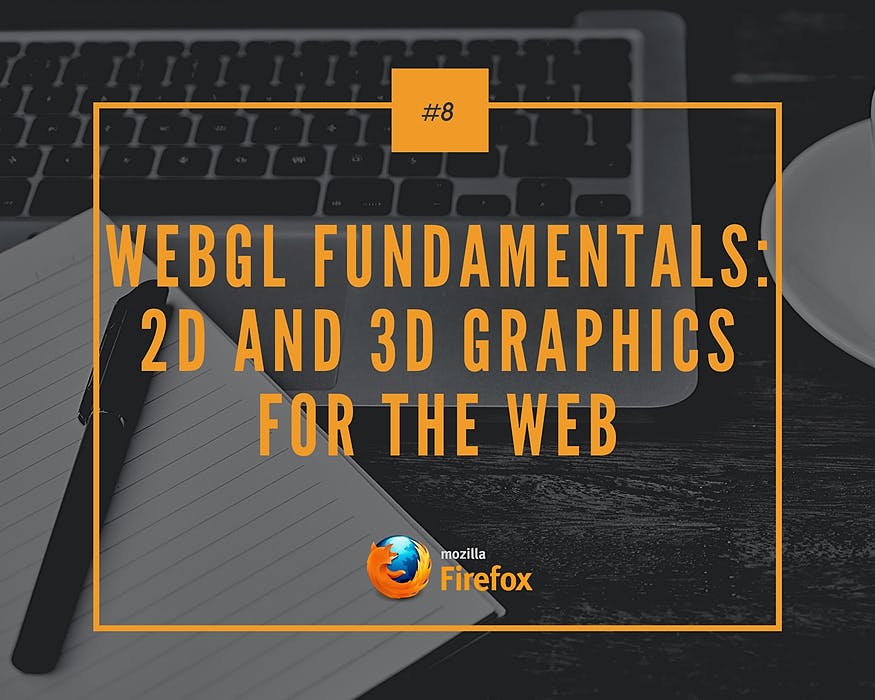WebGL (Web Graphics Library) is a JavaScript API for rendering high-performance interactive 3D and 2D graphics within any compatible web browser without the use of plug-ins. WebGL does so by introducing an API that closely conforms to OpenGL ES 2.0 that can be used in HTML5
<canvas>Support for WebGL is present in Firefox 4+, Google Chrome 9+, Opera 12+, Safari 5.1+, Internet Explorer 11+, and Microsoft Edge build 10240+; however, the user's device must also have hardware that supports these features.
The WebGL 2 API introduces support for much of the OpenGL ES 3.0 feature set; it's provided through the
WebGL2RenderingContextThe
<canvas>Reference
Standard interfaces- WebGLRenderingContext
- WebGL2RenderingContext
- WebGLActiveInfo
- WebGLBuffer
- WebGLContextEvent
- WebGLFramebuffer
- WebGLProgram
- WebGLQuery
- WebGLRenderbuffer
- WebGLSampler
- WebGLShader
- WebGLShaderPrecisionFormat
- WebGLSync
- WebGLTexture
- WebGLTransformFeedback
- WebGLUniformLocation
- WebGLVertexArrayObject
Extensions- ANGLE_instanced_arrays
- EXT_blend_minmax
- EXT_color_buffer_float
- EXT_color_buffer_half_float
- EXT_disjoint_timer_query
- EXT_float_blend
- EXT_frag_depth
- EXT_sRGB
- EXT_shader_texture_lod
- EXT_texture_compression_bptc
- EXT_texture_compression_rgtc
- EXT_texture_filter_anisotropic
- OES_element_index_uint
- OES_fbo_render_mipmap
- OES_standard_derivatives
- OES_texture_float
- OES_texture_float_linear
- OES_texture_half_float
- OES_texture_half_float_linear
- OES_vertex_array_object
- OVR_multiview2
- WEBGL_color_buffer_float
- WEBGL_compressed_texture_astc
- WEBGL_compressed_texture_atc
- WEBGL_compressed_texture_etc
- WEBGL_compressed_texture_etc
- WEBGL_compressed_texture_pvrtc
- WEBGL_compressed_texture_s3tc
- WEBGL_compressed_texture_s3tc_srgb
- WEBGL_debug_renderer_info
- WEBGL_debug_shaders
- WEBGL_depth_texture
- WEBGL_draw_buffers
- WEBGL_lose_context
EventsWebGL 2WebGL 2 is a major update to WebGL which is provided through the
WebGL2RenderingContext- 3D textures,
- Sampler objects,
- Uniform Buffer objects,
- Sync objects,
- Query objects,
- Transform Feedback objects,
- Promoted extensions that are now core to WebGL 2: Vertex Array objects, instancing, multiple render targets, fragment depth.
See also the blog post "WebGL 2 lands in Firefox" and webglsamples.org/WebGL2Samples for a few demos.
Guides and tutorials
Below, you'll find an assortment of guides to help you learn WebGL
concepts and tutorials that offer step-by-step lessons and examples.
concepts and tutorials that offer step-by-step lessons and examples.
Guides
A guide to variables, buffers, and other types of data used when writing WebGL code.
Tips and suggestions to help you improve the quality, performance, and reliability of your WebGL content.
A guide to using WebGL extensions.
Tutorials
Tutorials
A beginner's guide to WebGL core concepts. A good place to start if you don't have previous WebGL experience.
Examples
Examples
This example demonstrates the simple animation of a one-color shape. Topics examined are adapting to aspect ratio differences, a function to build shader programs from sets of multiple shaders, and the basics of drawing in WebGL.
A series of live samples with short explanations that showcase WebGL concepts and capabilities. The examples are sorted according to topic and level of difficulty, covering the WebGL rendering context, shader programming, textures, geometry, user interaction, and more.
Advanced tutorials
WebGL model view projection
Advanced tutorials
WebGL model view projection
A detailed explanation of the three core matrices that are typically used to represent a 3D object view: the model, view and projection matrices.
A useful guide to how 3D transform matrices work, and can be used on the web — both for WebGL calculations and in CSS3 transforms.
Resources
- Raw WebGL: An introduction to WebGL A talk by Nick Desaulniers that introduces the basics of WebGL. This is a great place to start if you've never done low-level graphics
programming. - Khronos WebGL site The main web site for WebGL at the Khronos Group.
- WebGL Fundamentals A basic tutorial with fundamentals of WebGL.
- WebGL playground An online tool for creating and sharing WebGL projects. Good for quick prototyping and experimenting.
- WebGL Academy An HTML/JavaScript editor with tutorials to learn basics of webgl programming.
- WebGL Stats A site with statistics about WebGL capabilities in browsers on different platforms.
Libraries
- glMatrix is a JavaScript matrix and vector library for high-performance WebGL apps.
- PhiloGL is a WebGL framework for data visualization, creative coding, and game development.
- Pixi.js is a fast, open-source 2D WebGL renderer.
- PlayCanvas is an open-source game engine.
- Sylvester is an open-source library for manipulating vectors and matrices. Not optimized for WebGL but extremely robust.
- three.js is an open-source, fully featured 3D WebGL library.
- Phaser is a fast, free and fun open source framework for Canvas and WebGL powered browser games.
- RedGL is an open-source 3D WebGL library.
- vtk.js is a JavaScript library for scientific visualization in your browser.
Specifications
Browser compatibility
WebGL 1
WebGL 2
Compatibility notes
In addition to the browser, the GPU itself also needs to support the feature. So, for example, S3 Texture Compression (S3TC) is only available on Tegra-based tablets. Most browsers make the
WebGLexperimental-webglwebgl2Gecko notes
WebGL debugging and testing
WebGL debugging and testing
Starting with Gecko 10.0 (Firefox 10.0 / Thunderbird 10.0 / SeaMonkey
2.7), there are two preferences available which let you control the
capabilities of WebGL for testing purposes:
2.7), there are two preferences available which let you control the
capabilities of WebGL for testing purposes:
webgl.min_capability_modeA Boolean property that, when
truefalsewebgl.disable_extensionsA Boolean property that, when
truefalseSee also
Credits
- Source: https://developer.mozilla.org/en-US/docs/Web/API/WebGL_API
- Published under Open CC Attribution ShareAlike 3.0 licence


